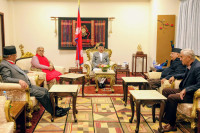Opinion
Advancing the frontiers of knowledge
What’s so super about supercomputers and why does Nepal need them anyway?
Abha Eli Phoboo
What used to take 45 days to process was completed in just 12 hours. And only one node had been used. The sample task was made for geomatic engineers to show how much faster supercomputers could process drone images taken to map topography for hydropower feasibility studies. There are 184 nodes at the High-Performance Computing Centre, housed partly at IT Park, Kavre and partly in Kathmandu University’s Dhulikhel campus. But first, what are supercomputers? Supercomputers are extremely powerful computers capable of performing complex calculations and data processing at incredible speed. To put it in perspective, an ordinary computer can process a few billion calculations per second, while a supercomputer can process quadrillions of calculations simultaneously per second. The equipment in Nepal was donated by CERN, the European Organisation for Nuclear Research, one of the most demanding computing environments in the research world.
In 2017, a year before the supercomputer was shipped from Geneva to Kathmandu, Nepal signed an International Cooperation Agreement with CERN to formalise relationships invested in creating access to train students and scientists with the view of future participation in global scientific projects at the laboratory. Experts from CERN have been visiting Nepal since 2013 as part of the particle physics master classes organised by Physics Without Frontiers to train university students. Several of these students have gone on to participate in CERN summer programmes.
Driver of innovation
In addition to the physics master classes, during the visits, several events were held over the years with policymakers and the diverse public to engage in dialogue on fundamental research as a driver of innovation. In the course of these events, the visiting team learned that every six months or so, hospitals in Nepal delete health image data—magnetic resonance imaging (MRI) and positron emission tomography (PET) scans—to make space for new images. This is detrimental for the quality of patients’ follow-up visits, predictive analysis, and affects evidence-based decisions on therapies prescribed. It also limits the potential for data-driven studies to inform health administration and policies.
Health, however, is not the only sector in Nepal that could use a massive upgrade in digital storage and processing power for data analyses. Scientists, students and researchers have been relying on other countries as does our government. The collection, storage and analysis of data helps understand trends, inform policies and transition from big-bank influenced strategies into an era of big data (evidence-based) influenced policies. The process could pave the way for a knowledge-based digital economy and also provide a larger and more reliable repository for learning. With supercomputers in Nepal, researchers can carry out modelling and simulation for seismological studies, climate change, virus outbreaks, the hydroelectric potential of different rivers, genetic analysis to screen new-born babies, and more. While disk space is cheap, analysis of big data requires massive computing power. Locally-based supercomputers cut down processing and transfer time significantly for researchers, and can serve as a secure digital space for data of national interest.
Nepal’s new High-Performance Computing Centre is coordinated and maintained by Kathmandu University with supercomputing expert Rajendra Adhikari, PhD, as its project leader, together with software, networking and electricity experts Kundan Lal Shrestha, PhD, Saran Shrestha and Diwakar Bista. The supercomputer is meant for educational and research purposes only, and even though the centre is still in its setting-up phase, the team members have begun training students and fellow faculty members. Immediately after the CERN shipment arrived in Kathmandu last August, Adhikari began training five students on supercomputing hardware installation and the testing of server nodes. They spent three months testing each node and establishing power requirements. In the same period, Adhikari won the Nvidia Corporation award for the latest GPU (graphics processing unit) card, valued at $3,000, which he added to the system. Among the High-Performance Computing team’s plans is to create sustainable sources of energy for the Centre to serve an environmentally-friendly facility.
In November 2018, the High-Performance Computing team organised an introductory training on supercomputers for 35 faculty and students. A month later, the supercomputer was used during particle physics master classes to give students from different colleges the opportunity to analyse real data from CERN’s Large Hadron Collider. The High-Performance Computing agenda includes plans to host periodic introductory sessions for students, with internships available for qualified candidates, and on-demand training available for academic and government institutions.
Fine-tuning performance
There is much yet to do in terms of ensuring the High-Performance Computing infrastructure is in working mode, and the supercomputer can be exploited to its full potential. The University of Arkansas, United States, is working on installing new software packages, in partnership with the local team. Continuous work is carried out on fine-tuning performance and overall efficiency of all components, including the cooling system, load balancing and job scheduling methods.
As the initial phase of testing nodes and software installation draws to a close, governance committees, stable teams and stakeholder details will need to be worked out. The High-Performance Computing Centre is meant for national capacity building in research with the aim of creating a cluster of institutions capable of participating in global scientific experiments. This means creating an environment that allows different educational and government players involved in scientific pursuits to come together selflessly to collaborate for the common goal of advancing the frontiers of knowledge.
Phoboo is the coordinator for Nepal, Physics Without Frontiers, International Centre for Theoretical Physics.




 13.12°C Kathmandu
13.12°C Kathmandu











